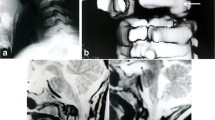Summary
This case report represents the findings of an abnormal atlas vertebra during dissection of 34 cadavers. The case which we describe appeared to have an atlas with a mass at a position similar to that of a centrum. This mass may have been a developmental abnormality of the centrum of the atlas or may have represented a congenital abnormality, known as the os odontoideum. Alternatively the abnormality may have been due to nonunion of an odontoid fracture, with subsequent fusion to the atlas. The case report will discuss which of these three alternatives is more probable, and the embryology and phylogenesis of the atlas and axis, leading us to believe in a congenital hypothesis as an explanation for the malformation.
Résumé
Cette publication rapporte la découverte d'une anomalie de l'atlas trouvée au cours d'une série de 34 dissections. Dans cette observation, l'atlas présente une masse osseuse située à la place topographique du corps vertébral. Cette anomalie peut être un corps embryologiquement anormal ou une autre anomalie congénitale décrite comme un “os odontoïde”. D'autre part, l'anomalie peut être due à la non consolidation d'une fracture de l'odontoöide suivie d'une fusion secondaire à l'atlas.
Cette observation permet de discuter lequel de ces trois mécanismes paraît le plus probable. L'étude embryologique et la phylogenèse du groupe atlas-axis conduisent à préférer l'hypothèse congénitale comme la plus vraisemblable pour expliquer l'anomalie osseuse rencontrée.
Similar content being viewed by others
References
Bailey DK (1962) The normal cervical spine in infants and children. Radiology 59: 712–719
Bergmann C (1845) Einige Beobachtungen und Reflexionen über die Skelettsysteme der Wirbeltiere, deren Begrenzung und Plan. Göttingen Studien, Göttingen, 191–254
Crockard HA, Heilman AK, Stevens JM (1993) Progressive myelopathy secondary to odontoid fracture: clinical, radiological and surgical features. J Neurosurg 78: 579–586
Crockard HA, Stevens JM (1995) Craniovertebral junction anomalies in inherited disorders: part of the syndrome or caused by the disorder? Eur J Pediatr 154: 504–512
Gadow HF (1933) The evolution of the vertebral column, a contribution to the study of vertebrate phylogeny. Cambridge University Press, Cambridge, pp 55–109
Grays Anatomy (1989) 37th edn. Churchill Livingstone, Edinburgh, p 328
Hawkins RJ, Fielding JW, Thompson WJ (1976) Os odontoideum; congenital or acquired? J Bone Joint Surg [Am] 58-A: 413–414
Hensinger RN, Lang JR, MacEwen GD (1974) The Klippel-Feil syndrome, a constellation of related abnormalities. J Bone Joint Surg [Am] 56-A: 1246–1253
Hensinger RN, Fielding JW, Hawkins RJ (1978) Congenital anomalies of the odontoid process. Orthop Clin North Am 9: 901–912
Holt RG, Helms CA, Munk PL, Gillespy T (1989) Hypertrophy of C1 anterior arch: useful sign to distinguish os odontoideum from acute cens fracture. Radiology 173: 207–209
Jenkins FA (1969) The evolution and development of the cens of the mammalian axis. Anat Rec 164: 173–184
Kaupp BF (1918) The anatomy of the domestic fowl. WB Saunders, Philadelphia London, pp 35–39
Lockhart RD, Hamilton GF, Fyfe FW (1965) Anatomy of the human body, 2nd edn. JB Lippincott, Philadelphia, p 68
MacAlister A (1894) The development and varieties of the second cervical vertebra. J Anat Physiol 28: 257–268
Michaels MD, Crang DF (1969) The pathological changes in a case of os odontoideum. J Bone Joint Surg [Am] 51-A: 965–972
Reese AM (1915) The alligator and its allies. Putnams, New York London, pp 50–58
Stevens JM, Chong WK, Barber C, Kendall BE, Crockard HA (1994) A new appraisal of abnormalities of the odontoid process associated with atlantoaxial subluxation and neurological disability. Brain 117: 133–148
Trotter M, Peterson RR (1966) Morris' Human Anatomy, 12th edn. McGraw-Hill, New York, p 144
Williston SW (1925) The osteology of the reptiles. Harvard University Press, Cambridge USA, pp 99–106
Wollin DG (1963) The os odontoideum. J Bone Joint Surg [Am] 45-A: 1459–1471
Author information
Authors and Affiliations
Rights and permissions
About this article
Cite this article
Choi, D., Abrahams, P. An atlas vertebra with a centrum? A case report of an abnormal atlas and axis. Surg Radiol Anat 19, 269–271 (1997). https://doi.org/10.1007/BF01627872
Received:
Accepted:
Issue Date:
DOI: https://doi.org/10.1007/BF01627872




